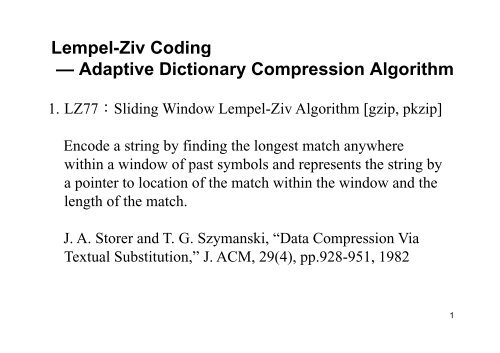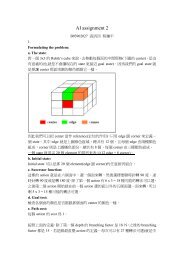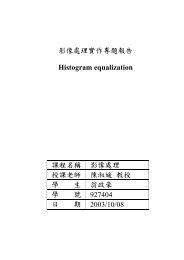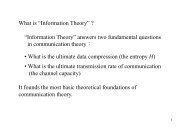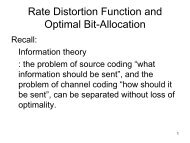Lempel-Ziv Coding p g — Adaptive Dictionary Compression Algorithm
Lempel-Ziv Coding p g — Adaptive Dictionary Compression Algorithm
Lempel-Ziv Coding p g — Adaptive Dictionary Compression Algorithm
You also want an ePaper? Increase the reach of your titles
YUMPU automatically turns print PDFs into web optimized ePapers that Google loves.
<strong>Lempel</strong>-<strong>Ziv</strong> p <strong>Coding</strong>g<br />
<strong>—</strong> <strong>Adaptive</strong> <strong>Dictionary</strong> <strong>Compression</strong> <strong>Algorithm</strong><br />
1. LZ77:Sliding Window <strong>Lempel</strong>-<strong>Ziv</strong> <strong>Algorithm</strong> [gzip, pkzip]<br />
Encode a string by finding the longest match anywhere<br />
within a window of past symbols and represents the string by<br />
a pointer to location of the match within the window and the<br />
length of the match.<br />
J. A. Storer and T. G. Szymanski, “Data <strong>Compression</strong> Via<br />
Textual Substitution, Substitution ” JJ. ACM ACM, 29(4) 29(4), pp.928-951, pp 928 951 1982<br />
1
AAssume we hhave a string i to bbe compressed df from a<br />
finite alphabet. A parsing S of a string is a division<br />
of the string into phrases separated by commas n x x x , , 1 2 L<br />
x1,<br />
x2,<br />
L,<br />
of the string into phrases, separated by commas.<br />
Let W be the length of the window. window<br />
Then the algorithm can be described as follows:<br />
Assume that we have compressed the string until time i −1.<br />
To find the next phrase, find the largest k such that for some j,<br />
i − 1 1− W ≤ j ≤ i − 1 1,<br />
th the string t i of f length l th k starting t ti at t j iis equal l<br />
to the string (of length k) starting at xi (i.e., x j+<br />
l xi+<br />
l for all =<br />
0 ≤ l < k k)<br />
).<br />
2
Th The next phrase h is i then h of f length l h k (i (i.e., xi, xi+<br />
1, L,<br />
xi+<br />
k−1<br />
) and d<br />
is represented by the pair (P, L), where P is the location of<br />
the beginning of the match and L is the length of the match match.<br />
If a match is not found in the window, window the next character is<br />
sent uncompressed.<br />
To distinguish between these two cases, a flag bit is needed,<br />
and hence the phrases p are of two types:(F, yp ( P, L) ) of ( (F, C), )<br />
where C represents an uncompressed character.<br />
3
NNote that h the h target of f a ( (pointer, i length) l h) pain i could ldextend d<br />
beyond the window, so that it overlaps with the new phrase.<br />
In theory, this match could be arbitrarily long; in practice,<br />
though though, the maximum phrase length is restricted to be less<br />
than some parameter.<br />
4
FFor example, l if W = 4 and d the h string i is i<br />
ABBABBABBBAABABA and the initial window is empty,<br />
the string will be parsed as follows:<br />
A, B, B, ABBABB, BA, A, BA, BA,<br />
which is represented by the sequence of “pointers”:<br />
(0,A), (0,B), (1,1,1), (1,3,6), (1,4,2), (1,1,1), (1,3,2), (1,2,2),<br />
where h the th flag fl bit is i 0 if there th is i no match t h and d 1 if there th is i a<br />
match, and the location of the match is measured backward<br />
from the end of the window. window<br />
5
4 3 2 1<br />
A B<br />
(0,A);(0,B) (1,1,1) B A B A ···<br />
(1,3,6)<br />
A B B ABBABBB···<br />
A B B A B B B ···<br />
longest match<br />
(1,3,2) ·· · B A B B B A A B A B A<br />
B B B A<br />
(1,1,1) A B A B A<br />
B B A A<br />
(132) (1,3,2) B BABA A B A<br />
A A B A<br />
(122) (1,2,2) B BA A<br />
6
2LZ78 2. LZ-78 Tree-structured T dL <strong>Lempel</strong>-<strong>Ziv</strong> lZi <strong>Algorithm</strong>s Al i h [GIF; [GIF<br />
compress on Unix]<br />
This algorithm parsed a string into phrases, where each<br />
phrase is the shortest phrase not seen so far far.<br />
This algorithm can be viewed as building a dictionary in<br />
the form of a tree, where the nodes correspond to phrases<br />
seen so far.<br />
This algorithm is simple to implement and has become<br />
popular p p as one of the early ystandard algorithms g for file<br />
compression on computers because of its speed and<br />
efficiency. It is also used for data compression in highspeed<br />
modems.<br />
7
FFor the h string: i : ABBABBABBBAABABAA ···,<br />
we parse it as<br />
A, B, BA, BB, AB, BBA, ABA, BAA,···<br />
After every comma, comma we look along the input sequence until<br />
we come to the shortest string that has not been marked off<br />
before before.<br />
Since this is the shortest string, all its prefixes must have<br />
occurred earlier. (Thus, we can build up a tree of these<br />
phrases.)<br />
8
IIn particular, i l the h string i consisting i i of fall ll but b the h last l bit bi of fthis hi<br />
string must have occurred earlier. We code this phrase by<br />
giving the location of the prefix and the value of the last<br />
symbol.<br />
Thus, the string above would be represented as:<br />
(0 (0,A), A) (0 (0,B), B) (2,A), (2 A) (2 (2,B), B) (1 (1,B), B) (4,A), (4 A) (5 (5,A), A) (3 (3,A), A) ···<br />
9
1 A 0A<br />
2 B 0B<br />
3 BA 2A<br />
4 BB 2B<br />
5 AB 1B<br />
6 BBA 4A<br />
7 ABA 5A<br />
8 BAA 3A<br />
0<br />
A B<br />
1<br />
2<br />
B A B<br />
7 ABA 5A 5 3 4<br />
A<br />
7<br />
A<br />
A<br />
8 6<br />
10
SSending di an uncompressed dcharacter h in i each hphrase h results l in i<br />
a loss of efficiency. It is possible to get around this by<br />
considering the extension character (the last character of the<br />
current phrase) as part of the next phrase.<br />
T. A. Welch, A technique for high-performance data<br />
compression, computer, 17(1) 17(1):pp.8-19, pp.8 19, 1984. LZW<br />
algorithm.<br />
11
Di <strong>Dictionary</strong> i<br />
current<br />
input look-ahead<br />
buffer<br />
c0 c1 L c j c j+<br />
1 L cM<br />
−1<br />
i ai+<br />
1<br />
a L<br />
ai+ 2 ai+N<br />
−1<br />
(1) Fi Find dth the longest l tmatch t hbbetween t the th strings ti stored t di in the th<br />
dictionary and the string, started at a , in the look-ahead<br />
i<br />
buffer buffer.<br />
Assume the starting address of the matched string in the<br />
dictionary is J and the longest match length is K (i.e.,<br />
A a , a , L,<br />
a })<br />
I<br />
= { i i+<br />
1 i+<br />
K−1<br />
12
(2) SSend d ( J , K K,<br />
ai+<br />
k ) tto th the ddecoder d<br />
update p the dictionary y by y ppushing g A I (the ( longest g matched<br />
string) + a i+<br />
k into the <strong>Dictionary</strong>.<br />
(3) fill the look-ahead buffer, starting at a i+<br />
k , from the<br />
following input string.<br />
(4) repeat step 1 until the end of the input.<br />
13


